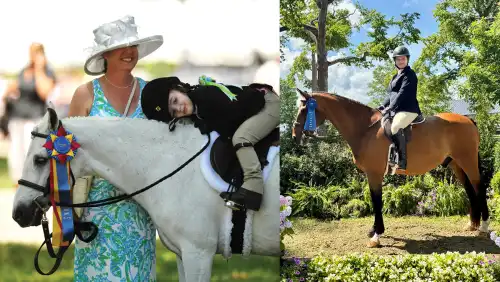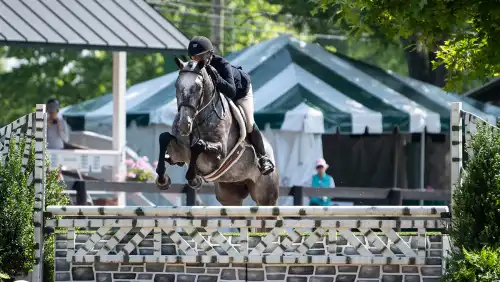When Walk The Line took his first lame step in 2013, Christina Samouhos thought the worst thing about it was the timing. “Johnny” and Samouhos were three days out from competing in the Marshall & Sterling League Children’s Medal, and at 17, Samouhos was in her last year of eligibility.
“To this day, I’m very unclear on how he got injured in the first place,” Samouhos said.
She borrowed a horse for the championship. When Samouhos returned home to Annandale, New Jersey, Johnny was still 2 out of 5 on the lameness scale.
The pair had only been together for two years. Her parents had purchased Johnny (Earl—Golden Lady) as a 6-year-old in 2011; he was meant to be a transition horse, carrying Samouhos out of the pony hunters and into the children’s and juniors.
“I actually hated Johnny when we went to go try him,” Samouhos admitted. “He was so young, and I was so green. I couldn’t get him to get a lead change. It just felt a mess. But my trainer, Kevin [McQueen], loved him. It took me a while to get used to him. We didn’t show at all until the next year.”

Christina Samouhos rehabbed Walk The Line for six years before he returned to the show ring in the adult equitation. Paws and Rewind Photo
The Hanoverian gelding’s striking black coat and consistency in the arena soon endeared him to his teenaged rider, but after his injury, it was clear he would be out of the show ring for a while.
He was initially diagnosed with a high suspensory on the right front. They gave him time off and gradually brought him back into work, but something still wasn’t quite right. Another veterinary examination found a disruption of the inferior check ligament, which runs along the back of the leg.
More time off followed, and they once again eased him back into work in 2015. Johnny had always had a few competition quirks, most notably an intense fear of tractors, so Samouhos and her sister Leah Samouhos showed him on the flat to increase his exposure.
But by the end of the summer, he was off again on the same leg. They initially suspected the check ligament, but when Janik Gasiorowski, VMD, DACVS, of Mid-Atlantic Equine in Ringoes, New Jersey, examined him, he found effusion in the tendon sheath, and Johnny blocked there instead of to the check ligament. “The ultrasound was initially unimpressive,” said Gasiorowski. “He inched along with a 0.5 to 1 out of 5 lameness, and finally in December of 2015 we did an MRI and found a chronic deep digital flexor tendon lesion.”
Gasiorowski recommended a tenoscopy to clean the area around the deep digital flexor tendon and reveal the size and location of the lesion with more precision.
“I was allowed into the surgical area with them and watched all of it,” Christina said. “The image from the tenoscopy looked like an atomic mushroom cloud had exploded in there.”
Gasiorowski said the tenoscopic debridement of the lateral lobe tear went well, but the annular ligament wasn’t restrictive, so he left it alone.
ADVERTISEMENT

Walk The Line underwent a tenoscopy to clean the area around the deep digital flexor tendon. Photo Courtesy Of Christina Samouhos
Christina spent most of the following year on the ground, hand walking Johnny and tending to his leg.
“He recovered well but went lame every time we tried to get him moving forward in rehab,” said Gasiorowski. Imaging revealed that the tear had actually gotten larger, and the annular ligament had expanded, crushing the digital flexor tendon sheath and preventing his forelimb from healing.
Gasiorowski performed a final surgery to slice part of the annular ligament and release the pressure on Johnny’s tendons, which meant another round of stall rest to allow the ligament to heal.
After his surgery, Johnny started corrective shoeing with farrier Pete Clausen. He wore a wedge to keep pressure off his heel and tendons. His therapy included use of an AquaPacer and occasional shockwave treatment.
“It’s easy to look back and question some of the decisions we made or things we didn’t do,” Samouhos said. “We never did any PRP, never did stem cells, never Pro-Stride, which is my go-to with most things nowadays. As a result, time gets a huge portion of the credit in Johnny’s rehab. Time and corrective shoeing, which was essential.”
During his layup, Christina initially was a working student for Heather Clark and then rode on her college Intercollegiate Horse Shows Association teams, first at Delaware Valley University (Pennsylvania), then at Centenary University (New Jersey), where she graduated with a bachelor’s degree in equine studies in 2019.
“I basically disappeared for the amount of time Johnny was injured,” Christina said. “I didn’t have a life. I started college, but I did most of my schoolwork at the barn. I spent every moment I could with him.
“I loved it though,” she continued. “I think it’s why he has the personality of a big puppy dog now, which he did not have when I first got him! During his rehab, sometimes during night checks I would close all the stalls and barn doors and let him out. He would just follow me around from stall to stall, smelling each horse, and he would come to me no matter what.”

Christina Samouhos believes the hours spent at the barn during Walk The Line’s rehab helped solidify their partnership. Photo Courtesy Of Christina Samouhos
Slowly, Gasiorowski increased Johnny’s exercise limits. Still unsure if Johnny would ever return to competition, Christina purchased Umara Z (Utrillo Z—Salina), a Zangersheide mare, and began competing again.
When Gasiorowski cleared Johnny for jumping, Christina hesitated.
“I’ve always been very anxious about Johnny. If he takes one tiny step incorrectly, I’m like, ‘No, he’s done! He’s not doing any more,’ ” Christina said. “Dr. Janik was really his cheerleader. He told me, ‘Johnny is giving us all the green lights. He wants to be back in work. He wants to do this.’ ”
Johnny started low, popping over small fences. Satisfied that he was back in work and happy, Christina passed the reins to Leah. A student of veterinary medicine, Leah seemed like the perfect person to keep Johnny going.
ADVERTISEMENT
In early 2019, he returned to the show ring at 2’6” as a test.
“We were blown away,” said Christina. “When you think about how long he was injured and how little time he had showing before that! Leah showed him a little more, and he was holding up so well. I was like, ‘Wait, what the heck? I’ve waited all this time, and you get to show him?’ ”
Christina took the reins back in 2020.
“I brought him to Anne [Kursinski] for the first time, and Anne was immediately like, ‘Why have you kept this horse away from me so long?’ ” Christina continued with a laugh. “She immediately loved him.”
Christina showed Johnny in the adult equitation classes in two shows last summer. His tractor quirk was still strong, but Kursinski came to her aid.
“We’re waiting to go in, and out comes the tractor, and I’m like, ‘Great, he’s going to lose his marbles,’ ” Christina said. “Anne said, ‘Drop your stirrups. You’re making him that way.’ And she was right! A big part of my education with Anne has been understanding the meaning of patience and of my role as the rider. Anne always says that if you want a better horse, be a better rider. It’s cold, but honestly, it’s true. I feel like a better rider for Johnny this time around.”
This January, Christina received an email from the U.S. Equestrian Federation saying they’d won a Horse of the Year award in the adult equitation for Zone 2.
“I just cried and cried,” Christina said. “All this horse has gone through. He has the biggest heart, and he’s an overachiever all the way. It’s probably how he got injured in the first place! I’m just really proud of him.”

Christina Samouhos couldn’t believe it when at the end of 2020 Walk The Line earned the Zone 2 Horse Of The Year title in the adult equitation. Photo Courtesy Of Christina Samouhos
As excited as Christina is by Johnny’s progress, she still worries about pushing him beyond his comfort zone, particularly now that he’s in his mid-teens. He still goes in corrective shoes: a bar with a 2-inch degree pad fitted by farrier Curt De Angelis.
Christina, 25, Pittstown, New Jersey, is working to become a professional trainer with Kursinski’s help. Her family owns a property that she’s renovating into a 60-stall barn, which will house her Skye Course Stables. And she still has some plans in the works for Johnny too.
“I am looking forward to doing some summer shows with him,” she said. “I would really love to do a 3′ derby with him; I think he would thoroughly enjoy it. Basically, anything that makes him happy or makes it seem like he’s enjoying his life a little more, I’m up for it. And, you know, that might mean him teaching a younger kid to jump and ride.
“Everyone in my family is like, ‘Why would you think like that? He’s doing so great!’” Christina continued. “And he is! But it’s taken a long time to get here. I don’t want him to break.”
Do you know a horse or rider who returned to the competition ring after what should have been a life-threatening or career-ending injury or illness? Email Kimberly at kloushin@coth.com with their story.














